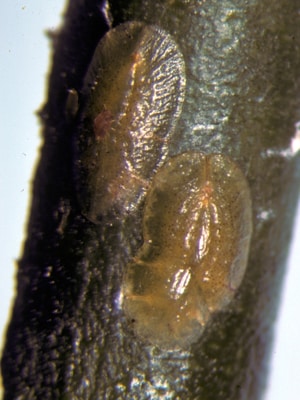Many species in the order Hemiptera by Jessica Walliser
Julie Bawden-Davis, author of Indoor Gardening the Organic Way, remembers the first time she encountered scale on one of her houseplants. “I found all this sticky stuff on the floor around my schefflera,” she says. “I firmly accused my kids of spilling something; then a moment later I realized I was standing in scale poop.” Davis’s experience is a typical one when scale insects are in the room. Because scales feed by sucking out plant sap, many of them excrete a sticky substance called honeydew. Its presence on floors or furniture is often the first indication of an infestation.
Mature scales appear as 1/8-to-1/5-inch oval bumps along plant stems and on the undersides of leaves. They’re hard to spot, because they look much like a part of the plant and they’re immobile. The only time scales move is when they are in their minuscule “crawler” stage. Females lay eggs under their hard shell; the eggs hatch into crawlers that move around the host plant to find a suitable place to attach themselves. Soon after they affix to the plant tissue, they form their own hard, protective covering, and there they sit, sucking out plant juices, excreting honeydew, and weakening the plant.
Scale is a common pest of many houseplants, including ficus, schefflera, ivies, pothos, citrus, spider plants, and palms. (Outdoors, scale can infest many plants, including fruit trees.) Carefully inspect newly purchased houseplants–or those being moved indoors for the winter–and quarantine them for 3 weeks to ensure they haven’t come with any piggybacking pests.
“Since their thick, shell-like coat is tough to penetrate, scales can be difficult to control,” Davis says. “The best nontoxic method is manual removal.” Crush the insects with a cotton ball or cotton swab soaked in isopropyl alcohol and continually monitor the plant for further infestations. Commercial preparations of insecticidal soap are effective, too. Use a sprayer to apply it to all plant surfaces every 7 to 10 days for 2 months. And, until the scale is gone, keep infested plants away from healthy ones.
Photo: United States National Collection of Scale Insects Photographs Archive, USDA Agricultural Research Service, Bugwood.org

